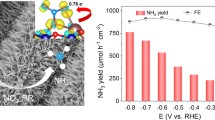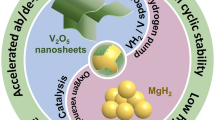Abstract
Moderate anionic doping is an effective approach to improve the performance of electrocatalysts toward hydrogen evolution reaction (HER) since it can adjust the electronic structure, active site, and phase. The reported studies mainly focus on designing P doped CoS2, while other phases of cobalt sulfide, such as Co1−xS and Co9S8 doped with P are rarely investigated for HER electrocatalysts. Herein, various cobalt sulfides (including CoS2/Co1−xS, Co1−xS, and Co9S8) doped with P are anchored on carbon cloth through a facile hydrothermal method. Among tested electrocatalysts, P doped Co1−xS exhibits excellent electrocatalytic performance with an overpotential of 110 and 165 mV (vs. RHE) for current densities of 10 and 100 mA·cm−2, respectively. Density functional theory calculations reveal that P doped Co1−xS possesses a smaller bandgap and more optimal hydrogen adsorption sites than pristine Co1−xS. This work initially investigates various cobalt sulfides doped with P and further gets insight into the activity improvement mechanism of P doping, which could guide the design of earth-abundant HER electrocatalysts for the “hydrogen economy”.

Similar content being viewed by others
References
Dresselhaus, M. S.; Thomas, I. L. Alternative energy technologies. Nature2001, 414, 332–337.
Liu, J.; Liu, Y.; Liu, N. Y.; Han, Y. Z.; Zhang, X.; Huang, H.; Lifshitz, Y.; Lee, S. T.; Zhong, J.; Kang, Z. H. Metal-free efficient photocatalyst for stable visible water splitting via a two-electron pathway. Science2015, 347, 970–974.
Tian, J. Q.; Liu, Q.; Cheng, N. Y.; Asiri, A. M.; Sun, X. P. Self-supported Cu3P nanowire arrays as an integrated high-performance three-dimensional cathode for generating hydrogen from water. Angew. Chem., Int. Ed.2014, 53, 9577–9581.
Turner, J. A. Sustainable hydrogen production. Science2004, 305, 972–974.
Nocera, D. G. The artificial leaf. Acc. Chem. Res.2012, 45, 767–776.
Subbaraman, R.; Tripkovic, D.; Strmcnik, D.; Chang, K. C.; Uchimura, M.; Paulikas, A. P.; Stamenkovic, V.; Markovic, N. M. Enhancing hydrogen evolution activity in water splitting by tailoring Li+-Ni(OH)2-Pt interfaces. Science2011, 334, 1256–1260.
Kibsgaard, J.; Tsai, C.; Chan, K. R.; Benck, J. D.; Nørskov, J. K.; Abild-Pedersen, F.; Jaramillo, T. F. Designing an improved transition metal phosphide catalyst for hydrogen evolution using experimental and theoretical trends. Energy Environ. Sci.2015, 8, 3022–3029.
Wu, T. L.; Pi, M. Y.; Zhang, D. K.; Chen, S. J. 3D structured porous CoP3 nanoneedle arrays as an efficient bifunctional electrocatalyst for the evolution reaction of hydrogen and oxygen. J. Mater. Chem. A2016, 4, 14539–14544.
Liao, L.; Wang, S. N.; Xiao, J. J.; Bian, X. J.; Zhang, Y. H.; Scanlon, M. D.; Hu, X. L.; Tang, Y.; Liu, B. H.; Girault, H. H. A nanoporous molybdenum carbide nanowire as an electrocatalyst for hydrogen evolution reaction. Energy Environ. Sci.2014, 7, 387–392.
Wu, T. L.; Dang, Y. L.; He, J. K.; Li, T.; Qu, G. X.; Gao, Y. Y.; Tan, F. R. Synthesis and mechanism investigation of three-dimensional porous CoP3 nanoplate arrays as efficient hydrogen evolution reaction electrocatalyst. Appl. Surf. Sci.2019, 494, 179–186.
Ye, R. Q.; del Angel-Vicente, P.; Liu, Y. Y.; Arellano-Jimenez, M. J.; Peng, Z. W.; Wang, T.; Li, Y. L.; Yakobson, B. I.; Wei, S. H.; Yacaman, M. J. et al. High-performance hydrogen evolution from MoS2(1−x)Px solid solution. Adv. Mater.2016, 28, 1427–1432.
Wang, D. Y.; Gong, M.; Chou, H. L.; Pan, C. J.; Chen, H. A.; Wu, Y. P.; Lin, M. C.; Guan, M. Y.; Yang, J.; Chen, C. W. et al. Highly active and stable hybrid catalyst of cobalt-doped FeS2 nanosheets-carbon nanotubes for hydrogen evolution reaction. J. Am. Chem. Soc.2015, 137, 1587–1592.
Cheng, L.; Huang, W. J.; Gong, Q. F.; Liu, C. H.; Liu, Z.; Li, Y. G.; Dai, H. J. Ultrathin WS2 nanoflakes as a high-performance electrocatalyst for the hydrogen evolution reaction. Angew. Chem., Int. Ed.2014, 53, 7860–7863.
Li, Y. G.; Wang, H. L.; Xie, L. M.; Liang, Y. Y.; Hong, G. S.; Dai, H. J. MoS2 nanoparticles grown on graphene: An advanced catalyst for the hydrogen evolution reaction. J. Am. Chem. Soc.2011, 133, 7296–7299.
Xie, J. F.; Zhang, H.; Li, S.; Wang, R. X.; Sun, X.; Zhou, M.; Zhou, J. F.; Lou, X. W.; Xie, Y. Defect-rich MoS2 ultrathin nanosheets with additional active edge sites for enhanced electrocatalytic hydrogen evolution. Adv. Mater.2013, 25, 5807–5813.
Xie, J. F.; Zhang, J. J.; Li, S.; Grote, F.; Zhang, X. D.; Zhang, H.; Wang, R. X.; Lei, Y.; Pan, B. C.; Xie, Y. Controllable disorder engineering in oxygen-incorporated MoS2 ultrathin nanosheets for efficient hydrogen evolution. J. Am. Chem. Soc.2013, 135, 17881–17888.
Yan, D. F.; Chen, R.; Xiao, Z. H.; Wang, S. Y. Engineering the electronic structure of Co3O4 by carbon-doping for efficient overall water splitting. Electrochim. Acta2019, 303, 316–322.
Zhang, X. W.; Meng, F.; Mao, S.; Ding, Q.; Shearer, M. J.; Faber, M. S.; Chen, J. H.; Hamers, R. J.; Jin, S. Amorphous MoSxCly electrocatalyst supported by vertical graphene for efficient electrochemical and photoelectrochemical hydrogen generation. Energy Environ. Sci.2015, 8, 862–868.
Wang, K.; Zhou, C. J.; Xi, D.; Shi, Z. Q.; He, C.; Xia, H. Y.; Liu, G. W.; Qiao, G. J. Component-controllable synthesis of Co(SxSe1−x)2 nanowires supported by carbon fiber paper as high-performance electrode for hydrogen evolution reaction. Nano Energy2015, 18, 1–11.
Brumme, T.; Calandra, M.; Mauri, F. First-principles theory of field-effect doping in transition-metal dichalcogenides: Structural properties, electronic structure, hall coefficient, and electrical conductivity. Phys. Rev. B2015, 91, 155436.
Liu, W.; Hu, E. Y.; Jiang, H.; Xiang, Y. J.; Weng, Z.; Li, M.; Fan, Q.; Yu, X. Q.; Altman, E. I.; Wang, H. L. A highly active and stable hydrogen evolution catalyst based on pyrite-structured cobalt phosphosulfide. Nat. Commun.2016, 7, 10771.
Zhang, J. Y.; Liu, Y. C.; Xia, B. R.; Sun, C. Q.; Liu, Y. G.; Liu, P. T.; Gao, D. Q. Facile one-step synthesis of phosphorus-doped CoS2 as efficient electrocatalyst for hydrogen evolution reaction. Electrochim. Acta2018, 259, 955–961.
Caban-Acevedo, M.; Stone, M. L.; Schmidt, J. R.; Thomas, J. G.; Ding, Q.; Chang, H. C.; Tsai, M. L.; He, J. H.; Jin, S. Efficient hydrogen evolution catalysis using ternary pyrite-type cobalt phosphosulphide. Nat. Mater.2015, 14, 1245–1251.
Ouyang, C. B.; Wang, X.; Wang, S. Y. Phosphorus-doped CoS2 nanosheet arrays as ultra-efficient electrocatalysts for the hydrogen evolution reaction. Chem. Commun.2015, 51, 14160–14163.
Zhu, H.; Zhang, J. F.; Yanzhang, R. P.; Du, M. L.; Wang, Q. F.; Gao, G. H.; Wu, J. D.; Wu, G. M.; Zhang, M.; Liu, B. et al. When cubic cobalt sulfide meets layered molybdenum disulfide: A core-shell system toward synergetic electrocatalytic water splitting. Adv. Mater.2015, 27, 4752–4759.
Zhang, R.; Wang, X. X.; Yu, S. J.; Wen, T.; Zhu, X. W.; Yang, F. X.; Sun, X. N.; Wang, X. K.; Hu, W. P. Ternary NiCo2Px nanowires as pH-universal electrocatalysts for highly efficient hydrogen evolution reaction. Adv. Mater.2017, 29, 1605502.
Wang, T. Y.; Du, K. Z.; Liu, W. L.; Zhu, Z. W.; Shao, Y. H.; Li, M. X. Enhanced electrocatalytic activity of MoP microparticles for hydrogen evolution by grinding and electrochemical activation. J. Mater. Chem. A2015, 3, 4368–4373.
Li, J. Y.; Zhou, X. M.; Xia, Z. M.; Zhang, Z. Y.; Li, J.; Ma, Y. Y.; Qu, Y. Q. Facile synthesis of CoX (X = S, P) as an efficient electrocatalyst for hydrogen evolution reaction. J. Mater. Chem. A2015, 3, 13066–13071.
Zhao, G. X.; Sun, Y. B.; Zhou, W.; Wang, X. K.; Chang, K.; Liu, G. G.; Liu, H. M.; Kako, T.; Ye, J. H. Superior photocatalytic H2 production with cocatalytic Co/Ni species anchored on sulfide semiconductor. Adv. Mater.2017, 29, 1703258.
Lyu, Y. H.; Wang, R. L.; Tao, L.; Zou, Y. Q.; Zhou, H. J.; Liu, T. T.; Zhou, Y. Y.; Huo, J.; Jiang, S. P.; Zheng, J. Y. et al. In-situ evolution of active layers on commercial stainless steel for stable water splitting. Appl. Catal. B: Environ.2019, 248, 277–285.
Bao, J.; Zhang, X. D.; Fan, B.; Zhang, J. J.; Zhou, M.; Yang, W. L.; Hu, X.; Wang, H.; Pan, B. C.; Xie, Y. Ultrathin spinel-structured nanosheets rich in oxygen deficiencies for enhanced electrocatalytic water oxidation. Angew. Chem.2015, 127, 7507–7512.
Jiang, J.; Gao, M. R.; Sheng, W. C.; Yan, Y. S. Hollow chevrel-phase NiMo3S4 for hydrogen evolution in alkaline electrolytes. Angew. Chem.2016, 55, 15240–15245.
Greeley, J.; Nørskov, J. K. Large-scale, density functional theory-based screening of alloys for hydrogen evolution. Surf. Sci.2007, 601, 1590–1598.
Govindasamy, G.; Murugasen, P.; Sagadevan, S. Optical and electrical properties of chemical bath deposited cobalt sulphide thin films. Mater. Res.2017, 20, 62–67.
Wang, Y. Q.; Zou, Y. Q.; Tao, L.; Wang, Y. Y.; Huang, G.; Du, S. Q.; Wang, S. Y. Rational design of three-phase interfaces for electrocatalysis. Nano Res.2019, 12, 2055–2066.
Acknowledgements
This work was financially supported by the National Natural Science Foundation of China (No. 21701153) and National Postdoctoral Program for Innovative Talents (No. BX201700042).
Author information
Authors and Affiliations
Corresponding author
Electronic Supplementary Material
Rights and permissions
About this article
Cite this article
Qu, G., Wu, T., Yu, Y. et al. Rational design of phosphorus-doped cobalt sulfides electrocatalysts for hydrogen evolution. Nano Res. 12, 2960–2965 (2019). https://doi.org/10.1007/s12274-019-2538-x
Received:
Revised:
Accepted:
Published:
Issue Date:
DOI: https://doi.org/10.1007/s12274-019-2538-x




